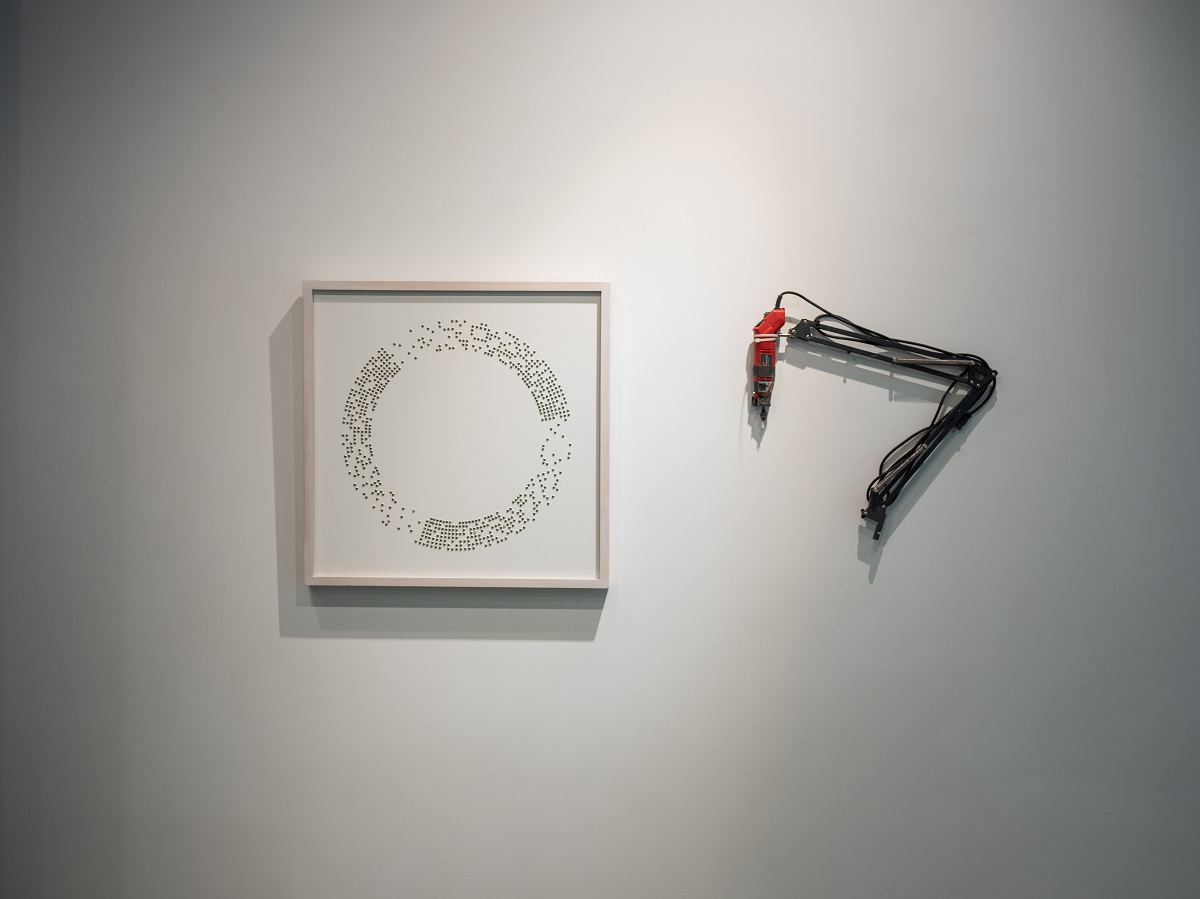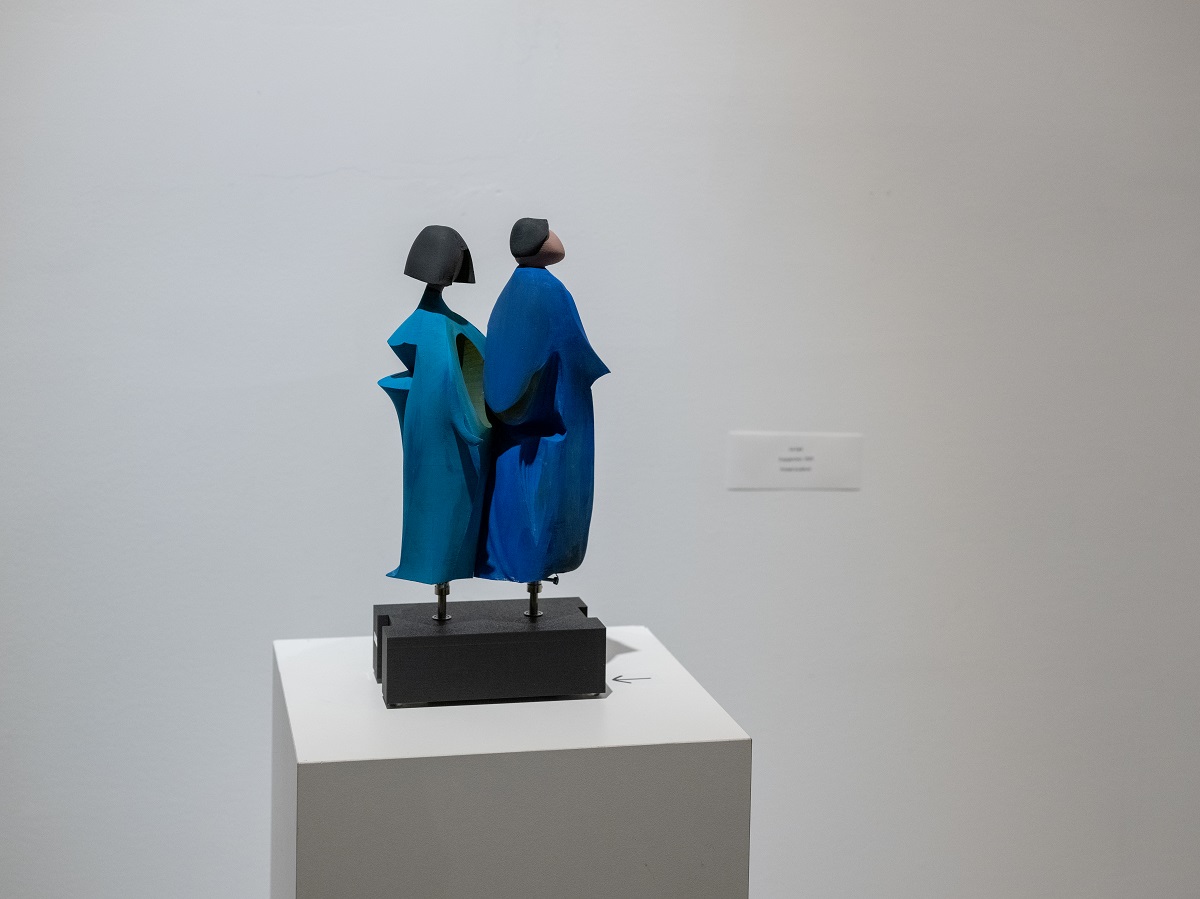
Graham Burns, Hardware Gradient no. 11, 2023, Multimedia wall piece, Mechanical Arm, 2023, Lamp arm, handheld electrical drill, Photographer Yufeng Zhao, Courtesy of curator
Toolish Behavior, the exhibition currently on view at the Clive Davis Gallery, was featured in Whitehot Magazine of Contemporary Art. The exhibition is on view until October 24th at 370 Jay Street.
"Humans use tools! Anthropologists have long argued that the use of tools was an important step in the evolution of humankind.1 Toolmaking and tool use have long been integral to humanity, so deeply woven into our existence that we often take them for granted. In the art world as well, exhibitions rarely foreground tools. Tools are too common, too ubiquitous: viewers assume that behind every artwork lies a hidden arsenal of implements but rarely pause to ask whether the ways we make and use tools carry a particular meaning.
At Clive Davis Gallery, however, Toolish Behavior does exactly that. Bringing together twelve artists and the tools they invented to make their works; the exhibition refuses to relegate tools to the background. Instead, tools are displayed alongside artworks as equally weighted presences, revealing the “toolish behavior” that underpins creative practice.
Curator shuang cai has long been fascinated by forms of labor that are usually considered too self-evident to warrant attention. In a previous exhibition, Labels? Labels! TBD, they highlighted the role of labels, those seemingly secondary, even invisible elements of an exhibition that usually appear last. With Toolish Behavior, their focus shifts from the margins to the middle of the artistic practice: the relationship between artists and their toolish behavior. Behind these customized tools lie hours of back-and-forth problem-solving, the detours of imagination, and the frustrations of trial and error. These tools testify not only to the outcome of a work but also to the fragile, contingent process that leads from concept to result. What could be more exhilarating than this exposure of making itself?
Arriving at the gallery, located on the ground floor of New York University’s 370 Jay Street building, I was immediately struck by the presence of these unconventional, non-standard, highly customized objects. Each tool carried visible traces of its making: an improvised solution, a form cobbled together, a handle adjusted to the maker’s particular grip. Their presence pulled me away from the present moment, toward deeper reflections on the long history of human life.
A tool, as the definition goes, is an object that extends our ability to shape the environment or accomplish a task.2 Before the Industrial Revolution, tools were the intimate products of individual or small-group craft; after the rise of mass production, tools became standardized, universalized, and detached from personal authorship. The very notion of standardization has since extended beyond material production to shape digital tools and application design. Today we live in a world saturated by standard parts and standardized formats: screws and bolts measured in interchangeable sizes, paper cut to uniform dimensions, image-editing apps offering the same presets for skin tones and filters. Human life itself is increasingly structured by standardized units, producing a world of repetitions and likenesses.
Standardization has obvious benefits. It improves efficiency, reduces costs, ensures consistency, and enables large-scale collaboration.3 Its logic aligns seamlessly with the imperatives of capitalism: faster, cheaper, more uniform, more scalable. Yet it is far from neutral. Standardization also consolidates power, naturalizes conformity, and marginalizes practices that fall outside its norms.3 In this system, people themselves are transformed into units of data—observed, measured, recorded, and fed into designs for more tools, more products, more systems of capture. What disappears in this process is the unruly, messy, unstandardizable dimension of human life itself.
To deviate from the standard, then, is costly. It requires more effort, more problem-solving, more negotiation with uncertainty. It produces messiness, awkwardness, and struggle. But it is precisely in these zones of difficulty that creativity takes root. The twelve artists in Toolish Behavior crafted tools that refuse the frictionless surface of the standardized. Their works stage a quiet but powerful resistance to the homogenizing conditions of modern life. And it reminds us that to make a tool is not only to solve a problem—it is to assert the possibility of other ways of living, other ways of making, other ways of being human.
In these works of Toolish Behavior, the artists speak to something more intimate: the ways in which tools emerge to solve needs that are personal, marginal, or simply overlooked by the logic of the standard. Sometimes these needs are born of exclusion, when existing tools fail to account for particular bodies. Sometimes they arise from the idiosyncratic demands of practice itself. In either case, the tool becomes an extension of body and thought, a prosthesis of creativity."
